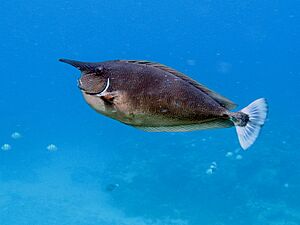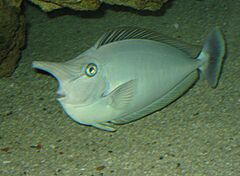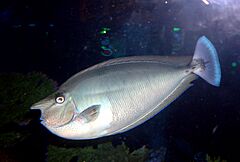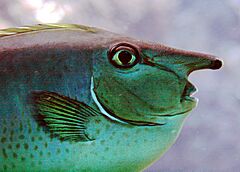Short-nosed unicornfish facts for kids
Quick facts for kids Short-nosed unicornfish |
|
|---|---|
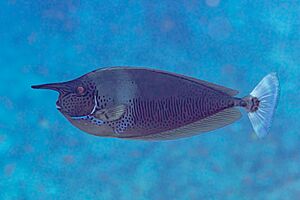 |
|
| Naso brevirostris at the French Polynesia | |
| Conservation status | |
| Scientific classification | |
| Synonyms | |
|
The Naso brevirostris, also known as the short-nosed unicornfish, is a cool fish found in the ocean. It gets its name from a special bump or "horn" on its head. This fish is part of a group called Acanthuridae, which includes surgeonfishes and tangs. You can find it in the Indian and western Pacific Oceans.
Contents
What's in a Name?
The scientific name for this fish is Naso brevirostris. It was first described in 1829 by a French scientist named Georges Cuvier. The word "brevirostris" means "short nose." This name helps tell it apart from other unicornfish that have longer snouts.
What Does It Look Like?
The short-nosed unicornfish can grow up to about 60 centimeters (about 2 feet) long. It has a unique look with a very short, steep snout. As they grow older, especially after they are about 10 centimeters long, a bony bump or "horn" starts to grow on their forehead. This horn can even extend past their mouth!
This fish has a dorsal fin (on its back) with 6 spines and 27 to 29 soft rays. Its anal fin (on its belly) has 2 spines and 27 to 29 soft rays. Near its tail, it has two bony plates on each side.
The color of the short-nosed unicornfish can be light bluish-grey or olive-brown. Sometimes, the front part of its body is much paler than the rest. You might see thin, dark grey lines on its sides, which break into small spots lower down. Its head often has small dark spots or a pattern of lines. The horn has diagonal black lines, and its lips have pale blue edges. The tail fin is mostly whitish.
Where Do They Live?
The short-nosed unicornfish lives in the warm waters of the Indian Ocean and Pacific Ocean. You can find them from the Red Sea all the way down the eastern coast of Africa to South Africa. They also live across the Indian Ocean to the western Pacific, reaching places like the Hawaiian Islands and Japan. In Australia, they are found along the northern coasts and in the Great Barrier Reef. They also live around the Galápagos Islands in the eastern Pacific.
These fish prefer to live in coral reefs, both in calm lagoons and on the outer parts of the reefs. They can be found at depths of up to 46 meters (about 150 feet).
Life Cycle and What They Eat
Short-nosed unicornfish gather together to lay their eggs. The males have larger bony plates near their tails than the females. After the eggs hatch, the baby fish (called larvae) float in the ocean for up to 90 days.
Young short-nosed unicornfish, called juveniles, mainly eat algae that grows on the ocean floor. But as they get older and their horn starts to grow, they change their diet. Adult fish mostly eat tiny, jelly-like animals called zooplankton that float in the water.
Unicornfish and People
People sometimes catch the short-nosed unicornfish for food using fish traps or spears. However, it's important to be careful because eating this fish can sometimes cause a type of food poisoning called ciguatera poisoning. This happens when the fish eats certain algae that have toxins.
You don't often see this fish in home aquariums. Because it lives in many places and its numbers seem stable, scientists consider it a species of "Least Concern" for conservation. This means it's not currently at high risk of disappearing.
Images for kids
-
Spotted unicornfish at the Toledo Zoo



